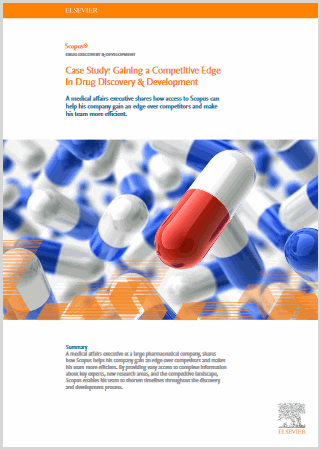Gaining a competitive advantage with Scopus: a case study for pharma
Getting a new drug to market as fast — and as safely — as possible is a key focus for any researcher or developer manager at a pharmaceutical company, regardless of size.
In such a competitive environment, facing a delay of just a few months can give a rival company the chance to get to market first, so it is important that your drug moves through every step, from trials to approval, at top speed. However, in drug development, where drug failure rates have become a challenge, you have to not only account for speed, but also the thoroughness and quality of the data you use to make the right decisions at every stage of development.
“Anything that can shorten our timelines and reduce drug failure rates gives us a competitive advantage.” — Mark Collin, Medical Affairs Executive
In the earlier discovery stages, a researcher who is able to efficiently tap into current research and scientific trends in different therapeutic areas has definitive advantages. These include identifying and building an expert network that you can harness because successful solutions are often borne out of partnering with startups, academic researchers, Clinical Research Organizations (CROs) and other trusted experts.
“Scopus helps us get from point A to point B in the most efficient and quickest way. We are also confident from our experience that we’re not missing anything.” — Mark Collin Medical Affairs Executive
Our recently developed case study for Scopus offers some lessons on this topic. It spotlights a medical affairs executive at a large pharmaceutical company who explains how high the financial stakes are for companies like his and details the time pressures that he faces. He explains how he uses Scopus to identify and engage with relevant external experts, keeps tabs on competitors and follows current research trends. Being able to do these tasks efficiently and effectively, and feeling confident that the information he uses is reliable and trustworthy, contributes to his company’s ability to gain speed, reduce drugs failure rates and keep one step ahead of his competition.


